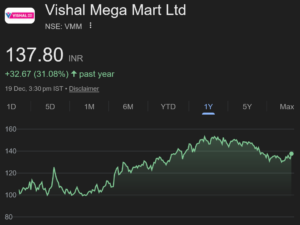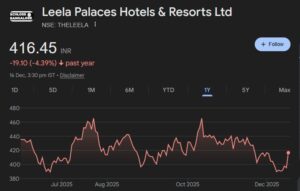
Shyam Sekhar Latest Portfolio
First, we have to peep into the latest portfolio of Shyam Sekhar to check the status of the multibaggers therein.
Jayant Agro-Organics is the flagship of the portfolio. Shyam is the Company’s single largest individual shareholder.
The stock is a stunning 10-bagger with an eye-popping 917% gain over 24 months.
Shyam Sekhar is a long-standing shareholder of Jayant Agro-Organics. He was first spotted in June 2015 with a holding of 187,675 shares in the Company.
At that time, the stock was available at the throwaway valuation of Rs. 95. The CMP is Rs. 980.
| Company | No of Shares (in Lakhs) | Rs Crore | YoY Gain (%) |
| Jayant Agro-Organics | 1.70 | 16 | 278 |
| Electrosteel Castings | 36.78 | 11 | 65 |
| Prima Plastics | 2.36 | 6 | 55 |
| Linc Pen and Plastics | 1.91 | 5 | 10 |
| Singer India | 2.27 | 5 | 23 |
| Rama Phosphates | 2.80 | 3 | 41 |
| Aries Agro | 1.53 | 2 | 22 |
In addition to the above, Shyam Sekhar has revealed that he and/ or his family members hold shares in HDFC Bank, Hatsun Agro, KRBL, La Opala, Balaji Amines, Khaitan Chemicals, sugar companies etc.
La Opala and Hatsun Agro are described as “high conviction stocks” while Jayant Agro is described as a “dividend play”.
My #TOP2 high conviction stocks are ones i own for the past 5 years & will own for the next 5. LA opala glass & Hatsun agro. Richly valued.
— Shyam Sekhar (@shyamsek) December 20, 2015
@ttthakur i own it for a long time. It's a dividend play for me.
— Shyam Sekhar (@shyamsek) December 26, 2015
Shyam Sekhar has also revealed that he follows the salutary practice of maintaining a “core” and a “satellite” portfolio (see The tail can wag the dog too). Stocks which are under probation are quarantined in the “satellite” portfolio till they prove their mettle and get upgraded to “core” status.
@Manish1S In a portfolio, about 10 stocks will be 80%. The rest will be ideas in the making.
— Shyam Sekhar (@shyamsek) August 28, 2014
Sintex Industries, the “ugly duckling” multibagger
Shyam Sekhar’s latest stock recommendation is Sintex Industries.
It may be recalled that Sintex Industries recently demerged its high RoE plastics division into Sintex Plastics (which is awaiting listing) and is left with the low RoE, capital intensive textiles division.
Shyam Sekhar described Sixtex Industries as an “ugly duckling” on the basis that it has been discarded by the stock market and is available at throwaway valuations.
Transformation from low-end to high-end textiles manufacturer
Shyam explained that Sintex Industries’ business is undergoing a subtle transformation which the market is not paying attention to.
These factors are the following:
(a) The company is transforming from a manufacturer of high end fabric to compact yarn. This transformation happened in 2 phases and it incurred a capital expenditure of 4,300 crores. Compact yarns have better margins, has less wastage, and they are preferred by high end fabric makers.
(b) Once phase 2 goes live (in Aug 2017) Sintex will have 6 lac spindles. This will make Sintex the largest compact yarn player in India. The age of the spindles directly impacts the cost and productivity of the yarn.
Vardhman Textiles is the best player in the industry. 68 percent of Vardhman’s spindles is under 10 years of age. Sintex, with brand new spindles, will have higher productivity and lower cost than Vardhman Textiles.
(c) Sintex turns over its inventory every 39 days. This is the best in the industry. Trident is the 2nd best player. It turns over the inventory every 61 days.
Competitive advantages of Sintex versus its peers
Shyam explained that Sintex enjoys several competitive advantages which give it an edge over its arch rivals.
First, Sintex is located in Gujarat which is the heart of cotton in India. So, the raw material is available at cheaper rates because the transportation costs are lower.
Second, the State of Gujarat provides financial incentives to encourage cotton businesses. This is reflected by the fact that Sintex borrows funds at a throwaway interest rate of only 2 percent.
Third, Sintex’s spinning plant is a mere 10 kms away from the Pipavav port. This provides enormous cost advantages because 38 percent of the sales are from exports.
Throwaway valuations
Shyam Sekhar is known to be an old-school investor. He pays close attention to old-fashioned concepts of valuation of the stock which novice investors throw to the winds.
He emphasized that while Sintex’s book value per share is Rs. 72, the stock is quoting at Rs. 25.
So, there is enormous ‘margin of safety’ because one is buying a dollar at only 35 cents, Shyam exclaimed in an excited tone and with a glint in his eyes.
SINTEX brought back Grahamian learning to forefront. Such poor math by value investors only shows the hollowness of our learning.
— Shyam Sekhar (@shyamsek) May 26, 2017
Sintex’s textile segment is on the cusp of a turnaround: Systematix
Shyam Sekhar’s theory with regard to the textile business of Sintex is corroborated by Systematix, a leading equity research house.
Systematix has opined that the textile segment is “on the cusp of a turnaround” and will “drive growth in future”. The logic is as follows:
“Sintex’s fiber-to-fabric business is the one of the oldest segment which contributes ~12% to the total revenue of the company. This segment is more focused on high end, value driven, and margin accretive products in the niche markets of the textile industry. In Q1FY17, Sintex has commenced commercial production of Phase 1 spinning plant (compact cotton yarn) at Pipavav with a capacity of 3.3 lakhs spindles running at ~80-85% capacity utilization in 9MFY17. The company is also in process of setting up another 3 lakhs spindles unit for blended yarn with a CAPEX of Rs. 2100 crs with an expected IRR of ~16-18%. The textile segment has the advantages of raw material cost, government textile policy, attractive power rates available at plant and many other benefits from the government which may resulting in healthy return ratios.”
What about the textile stocks in Dolly Khanna’s portfolio?
At this stage, we must note that Dolly Khanna is a great believer in the prospects of the textile sector.
She has packed her portfolio with four magnificent textile stocks as of date.
| Stock | Nos of shares (in Lakhs) | Value (Rs Cr) | YoY Gain (%) |
| Trident | 53.17 | 43 | 61 |
| RSWM | 4.52 | 18 | (6) |
| Nandan Denim | 6.18 | 9 | 7 |
| Nitin Spinners | 6.21 | 8 | 71 |
| Total | 78 |
Trident, which is Dolly’s high-conviction pick, is a hot favourite amongst the intelligentsia.
The stock is highly recommended by Jash Kriplani of Outlook Business and Kshitij Kazi of Edelweiss.
There is also an investors’ presentation which makes for interesting reading.
Nandan Denim, which is presently in the doldrums, will be re-rated and deliver 32.6% gain is the confident assurance of Ventura Securities.
The Chirpals, the promoters of Nandan Denim, have been on an aggressive buying spree lately, which implies that the stock will see sunny days soon.
Keep an eye on Nandan Denim, Promoter has been increasing stake
Bought 2.5 lkh shares from the open market in the last 1-2 weeks— ronith ramesh (@ronith_28) July 3, 2017
Nandan Denim is also wooing big-ticket investors. If even one of them shows interest, it is sufficient to send the stock surging into the stratosphere.
Nandan Denim met some big funds today
1.Motilal Oswal
2. Barings Private Equity
3. Crest Capital
4. Birla Mutual Fund
5. GMO— ronith ramesh (@ronith_28) June 23, 2017
Textile industry size to touch $250 billion in 2 years
Kavita Gupta, the Textile Commissioner, has laid bare the plans of the Government to revive the textile sector.
“We see tremendous growth potential for the textile industry and it is expected to touch $250 billion in the next two years from the present $150 billion,” she said with immense confidence in her tone.
“We are also looking at modernising the machines and trying to add state-of-the-art facilities, which will help the sector. In addition, the government announced Rs 6,000-crore special packages for the industry last year,” she added.
She emphasized that rebates on state levies have been introduced to encourage exports.
She also pointed out that there is an additional 10 per cent subsidy for the garment and made up segments, which means the home textile industry will get an effective 25 per cent capital investment subsidy on the new machines they bring in, leading to efficiency and modernisation of the sector.
GST provides a strong fibre for textiles: Smriti Irani
Hon’ble Smriti Irani, the illustrious Textiles Minister, has given a detailed explanation on why GST will be a “harbinger of good tidings” for the entire textiles sector.
The bottom-line of her exposition is that all players planning major expansion will be facilitated in view of the rationalization and avoiding cascading of taxes.
Conclusion
In hindsight, it appears that we committed a big blunder by not piling on to Sintex prior to the demerger announcement. There has been enormous value unlocking which we missed out on. Hopefully, we can make amends by loading onto either or both of the Sintex’s post demerger!







Dolly Khanna bought “AKSHARCHEM (INDIA) LTD”.
We should refrain from making such comments unless there is data to substantiate the claim. Shareholding does not reflect stake by Dolly Khanna.
when did she buy dineshji?
http://www.bseindia.com/corporates/shpPublicShareholder.aspx?scripcd=524598&qtrid=94.00&QtrName=June%202017
She bought 76003
Dineshji
Is it possible to know all holdings of Dolly Khanna >1% for the quarter ending June 2017?
This “Ugly Ducking” will prove to be a biggest multi-bagger of 2017, kudos Shyam Sekar 🙂
Exactly an year later. The dcling has become uglier.
Shyam Sekhar is also invested 1% in Excel Industry. It’s a proxy to Agrochemicals, waste Management & speciality chemicals. Anyone tracking Excel Industry?
I have my money on this stock, expecting multibagger gains
Sintex looks to be good bet but for only long term three years or more.
Perhaps, Trident is a better bet.
From the article “enormous ‘margin of safety’ because one is buying a dollar at only 35 cents, Shyam exclaimed in an excited tone and with a glint in his eyes.” Well “Duckling” has become uglier. What is the view now? Is it going to survive or will sink to the bottom of the lake.